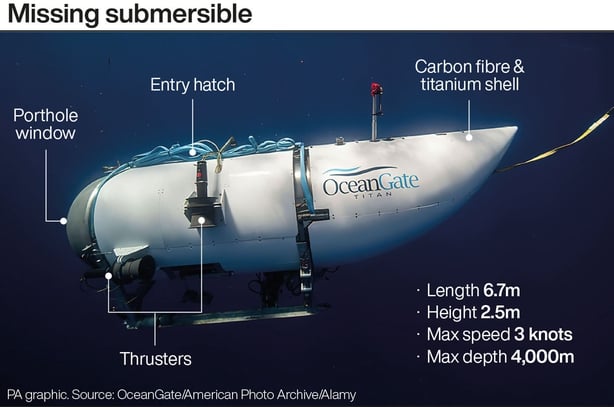The five people aboard a missing submersible died in a "catastrophic" event, a US Coast Guard official has said, bringing an end to the search for the vessel that was lost during a voyage to the Titanic.
"These men were true explorers who shared a distinct spirit of adventure, and a deep passion for exploring and protecting the world's oceans," OceanGate Expeditions said in a statement.
"Our hearts are with these five souls and every member of their families during this tragic time."
An unmanned deep-sea robot deployed from a Canadian ship discovered a debris field from the submersible this morning about 1,600 feet (488 metres) from the bow of the century-old wreck, 4km below the surface, US Coast Guard Rear Admiral John Mauger said at a press conference.
"The debris is consistent with a catastrophic loss of the pressure chamber," Mr Mauger said.
Rescue teams from several countries have spent days searching thousands of square miles of open seas with planes and ships for any sign of the 6.7m Titan, operated by US-based OceanGate Expeditions.
The submersible lost contact on Sunday morning with its support ship about an hour and 45 minutes into what should have been a two-hour descent.
The five people aboard included the British billionaire and explorer Hamish Harding, 58; Pakistani-born business magnate Shahzada Dawood, 48, and his 19-year-old son, Suleman, both British citizens; French oceanographer and Titanic expert Paul-Henri Nargeolet, 77, who had visited the wreck dozens of times; and Stockton Rush, the American founder and chief executive of OceanGate, who was piloting the submersible.
Mr Mauger said it was too early to tell when Titan met its fate.
The search operation had sonar buoys in the water for more than three days in the area without detecting any loud, violent noise that would have been generated when the submersible imploded, Mr Mauger said.
But the position of the debris field relatively close to the shipwreck and the time frame of the last communication with the Titan seemed to suggest the failure occurred near the end of its descent on Sunday.
The buoys had picked up some sounds on Tuesday and Wednesday that temporarily offered hope that the Titan was still intact and that its occupants were alive and trying to communicate by banging on the hull.
But officials said analysis of the sound was inconclusive and that the noises probably emanated from something else.
"There doesn't appear to be any relation between the noises and the location of the debris field on the sea floor," Mr Mauger said at the press conference.
Robotic craft on the ocean floor will continue to gather evidence, he said, but it was not clear whether recovering the victims' remains will be possible given the nature of the accident and the extreme conditions at those depths.
The search had grown increasingly desperate when the submersible's estimated 96-hour air supply had been expected to run out if the Titan were still intact.

The Titanic, which sank in 1912 on its maiden voyage after hitting an iceberg, killing more than 1,500 people, lies about 1,450km east of Cape Cod, Massachusetts, and 640km south of St John's, Newfoundland.
The expedition to the wreck, which OceanGate has been operating since 2021, cost $250,000 per person, according to OceanGate's website.
Questions about Titan's safety were raised in 2018 during a symposium of submersible industry experts and in a lawsuit by OceanGate's former head of marine operations, which was settled later that year.
The sweeping search covered more than 10,000 square miles of ocean - about the size of the US state of Massachusetts.

We need your consent to load this rte-player contentWe use rte-player to manage extra content that can set cookies on your device and collect data about your activity. Please review their details and accept them to load the content.Manage Preferences
Today, the deployment of two specialised deep-sea unmanned vehicles expanded the effort to the ocean's depths, where immense pressure and pitch-black darkness had promised to complicate any rescue mission.
The missing submersible and subsequent hunt captured worldwide attention, in part due to the mythology surrounding the Titanic.
Read more
Sub chief's wife descendent of Titanic victims - report
Titan sub: What is a 'catastrophic implosion'?
5 people who died on board missing sub near Titanic
Five "major pieces" of debris from the Titan submersible were recovered, the US Coast Guard said.
They include part of the pressure chamber, the nose cone, the front-end bell and the aft-end bell.
Rear Admiral Mauger said: "This is an incredibly complex operating environment on the sea floor over two miles beneath the surface."
Undersea expert Paul Hankin said: "We found five different major pieces of debris that told us that it was the remains of the Titan.
"The initial thing we found was the nose cone which was outside of the pressure hull.
"We then found a large debris field.
"Within that large debris field we found the front-end bell of the pressure hull. That was the first indication that there was a catastrophic event.
"Shortly thereafter we found a second smaller debris field. Within that debris field we found the other end of the pressure hull - the aft end bell - which basically comprises the totality of that pressure vessel."
Additional reporting PA

